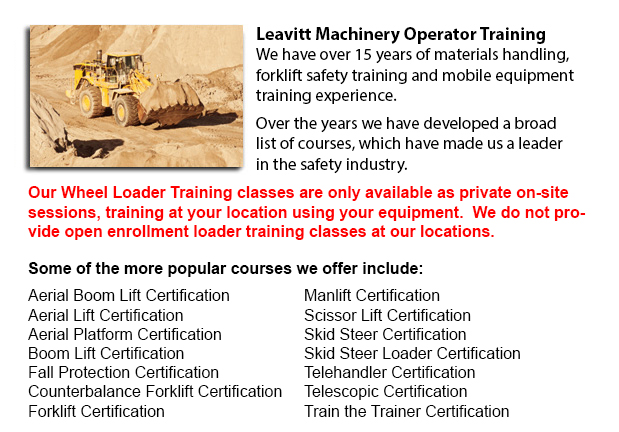
Wheel Loader Operator Training Oakville - Cranes are industrial equipment which use pulleys or levers so as to pick up significant weights. The Roman people utilized cranes in order to construct large monuments, which means these equipment have been around for at least two thousand years. Several Medieval churches used cranes in their structure and the Egyptians may have used them when building the pyramids.
Modern cranes can either be complex or simple, based upon the nature of the function they are able to do. For example, mobile cranes are quite simple models. A telescopic boom and even a steel truss mounts its movable platform. A system of levers or pulleys raises the boom and there is normally a hook suspended. These cranes are often utilized for earthmoving or demolition by changing the hook out with another piece of gadget like a bucket or wrecking ball. Telescopic cranes have a series of hydraulic tubes that fit together to form the boom. These models can even be mobile.
Both traditional or specialized wheels could be designed for railroad track or caterpillar track enabling these boom trucks to be able to move on upaved and uneven surfaces.
Rough terrain and truck mounted cranes are mobile too. Outriggers are placed on the truck mounted model in order to improve stability, while rough terrain cranes include a base which tends to resemble the bottom of a 4-wheel drive. These cranes are equipped so as to function on uneven ground making them ideal in the construction industry for instance.
Gantry cranes are actually utilized so as to transfer and unload big containers off of trains and ships. They are normally found functioning in railroads and ports. Their bases include huge crossbeams that run on rails to be able to lift containers from a location to another. A portainer is a unique type of gantry which transfers supplies onto and off of ships specifically.
Important to the shipping trade, floating cranes can be mounted on barges or pontoons. Being placed in water, they are perfect for utilization in building bridges, port construction and salvaging ships. Floating cranes are capable of handling very heavy loads and containers and similar to portainers, they could even unload ships.
Loader cranes have hydraulic driven booms which are fitted onto trailers in order to load things onto a trailer. The jointed sections of the boom can be folded down when the machinery is not in being used. This particular type of crane can be even considered telescopic for the reason that a section of the boom may telescope for more versatility.
Stacker cranes are often seen in automated warehouses. They tend to follow an automated retrieval system and could perform by remote. These cranes are outfitted along with a forklift apparatus and could be seen in big automated freezers, obtaining or stacking foodstuff. Using this type of system allows staff to remain out of that cold environment.
Tower cranes, often the tallest type, typically do not have a movable base. They should be put together piece by piece. Their base is similar to a long ladder with the boom at a 90 degree angle to the base. These cranes specialize in the construction of tall buildings and are often connected to the inside of the building itself during the construction period.
-
Order Picker License Oakville
Order Picker License Oakville - Order preparation operation or order picking as it is more normally known is a method used within warehouse operations and consists of employees called order pickers. The order picker's task is to collect and take arti... More -
Forklift Operator Certification Oakville
Forklift Operator Certification Oakville - Forklift operator certification is normally needed for personnel working within industrial, warehouse or construction setting to guarantee the safe utilization of forklifts. Workplace training need to follow... More -
Scissor Lift Certification Oakville
Scissor Lift Certification Oakville - A lot of worksites and tradespeople like iron workers, welders and masons utilize scissor lift platforms to help them reach elevated work areas. The utilization of a scissor lift is usually secondary to their tra... More -
Forklift Training Courses Oakville
Forklift Training Courses Oakville - When forklift operator safety training is customized for illiteracy, training time is reduced by 50%. Train the trainer, forklift training certification and lift-truck operator driver safety training evaluation pr... More -
Manlift Training Oakville
Manlift Training Oakville - There are numerous manlift training programs which offer a review of the manlift machinery. The practicum portion of the training is one more vital portion of the course. In this section the trainee has chance to demonstra... More -
Boom Lift License Oakville
Boom Lift License Oakville - To operate an aerial boom lift, operators should be licensed through training that can be obtained utilizing both classroom sessions and practical training and by attaining a boom lift license. Instruction should be given... More -
Crane / Overhead Crane / Self-Erect Crane / Truck Mounted Crane / Hydraulic Cranes Training in Oakville
Bridge cranes or likewise called overhead cranes are actually a type of industrial material handling crane using a line and hook mechanism that runs on a horizontal beam running along two widely separated rails. Several overhead cranes could be seen... More -
Telehandler Training in Oakville
Telescopic handlers normally called telehandlers for short, are an extremely popular piece of heavy construction machinery. They are widely utilized in the construction and agricultural trades. These machines have maximum reaching ability and could g... More

Forklift Training Oakville
TOLL FREE: 1-888-254-6157
Oakville, Ontario
forklifttrainingoakville.com
Email Us
About Us


